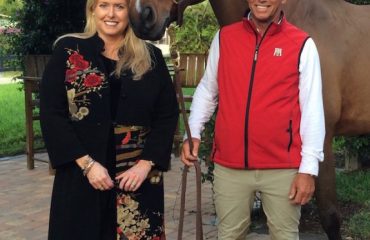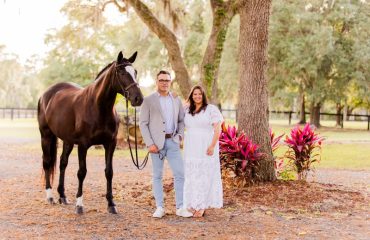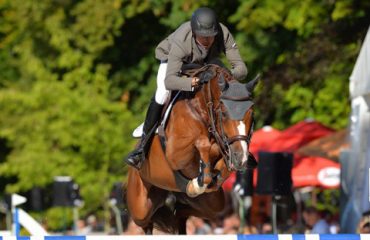 Richard Wheeler, DVM, was born in the U.K. and graduated from the Royal Veterinary College, London, in 2002. Dr. Wheeler then completed a two-year internship at Greenwood, Ellis and Partners (now Newmarket Equine Hospital) in Newmarket. In 2005, he moved to Wellington, Florida, to join Palm Beach Equine Clinic and he became a partner in 2009. Dr. Wheeler’s primary concentration is equine sports medicine. He is an FEI Veterinary Delegate for Show Jumping and Dressage and has authored several published articles on the topic of equine sports medicine. Dr. Wheeler has served on the board of the USHJA Horse and Rider Advocates Committee. In 2016, Dr. Wheeler became a founding director of the Sport Horse Research Foundation. Dr. Wheeler and his wife, Jessica, have two children. Do you have a question you want Dr. Wheeler to answer? Send questions to editor@sidelinesnews.com.
Richard Wheeler, DVM, was born in the U.K. and graduated from the Royal Veterinary College, London, in 2002. Dr. Wheeler then completed a two-year internship at Greenwood, Ellis and Partners (now Newmarket Equine Hospital) in Newmarket. In 2005, he moved to Wellington, Florida, to join Palm Beach Equine Clinic and he became a partner in 2009. Dr. Wheeler’s primary concentration is equine sports medicine. He is an FEI Veterinary Delegate for Show Jumping and Dressage and has authored several published articles on the topic of equine sports medicine. Dr. Wheeler has served on the board of the USHJA Horse and Rider Advocates Committee. In 2016, Dr. Wheeler became a founding director of the Sport Horse Research Foundation. Dr. Wheeler and his wife, Jessica, have two children. Do you have a question you want Dr. Wheeler to answer? Send questions to editor@sidelinesnews.com.
My horse is suddenly misbehaving, being very resistant while being worked and running away from contact. It isn’t a new bit, but one we’ve used for years. Could there be something bothering his mouth?
Such signs are not uncommon and can result from several causes. In fact, we are often presented with much more subtle signs, such as the rider feeling the horse is heavier in one rein or has less flexion to one side. I like to approach these cases with a list of potential problems and work from the simplest (and usually more common) to the more complicated. If I were presented with this case, I’d start with a clinical exam of the head and neck. This would include an oral exam using a speculum, palpation of the bone and soft tissue structures and manipulation of the temporomandibular joints (TMJ), neck and back. I’d examine the horse at rest, while being tacked up and under saddle. During this exam, we’re likely to find an area that warrants further investigation.
With such a severe presentation, I would expect to find something obvious during a clinical exam, but as we all know, some horses don’t read the book. Often, we find dental issues that can be resolved with appropriate floating and rebalancing. It’s fairly common to find issues with the bars (where the bit sits) or poll where pressure is exerted with some bit and bridle combinations. Generally, working with your trainer, I would expect to find a solution.
As my mother would say, “Common things are common,” so I expect a simple resolution to your problem. However, sometimes we have to dig further and this is where things get challenging for the veterinarians. In my experience, TMJ problems are not common, but we do see them on occasion. During my career, we have, as a profession, made great advances in the diagnosis and treatment of neck problems, and this is now a commonly recognized site of pathology in equine sports medicine.

PegasoTM Computed Tomography (CT) of the head and neck of a standing horse at Palm Beach Equine Clinic, Wellington, Florida
Photo by Richard Wheeler, DVM
I am excited that Palm Beach Equine Clinic has recently invested in a Pegaso CT scanner, which is capable of imaging the head and neck of a horse standing, without the use of general anesthesia. I think this is going to be a game-changing investment that allows us to image this complex region easily and safely, allowing a more accurate diagnosis and therefore the ability to provide better treatment options. We have already evaluated enlightening cases with TMJ disease and neck problems. Such accurate diagnostic imaging gives us the confidence to pursue more cutting-edge treatment options.
Though the answer to your problem is likely simple, there are many new and exciting advances in veterinary care that might be applicable.
My horse suffered an injury to the foot, and after an MRI examination, a surgery called navicular bursoscopy has been recommended. Have you seen good results with this procedure?
I think this is a very useful procedure and one that is routinely performed at PBEC, so we’ve seen a good number of cases.
The procedure involves the insertion of an arthroscopy camera (think key-hole surgery) through the bottom of the digital flexor tendon sheath in the pastern region. A hole is then made between the tendon sheath and navicular bursa, giving the surgeon a good view of the navicular bursa, flexor surface of the navicular bone and adjacent deep digital flexor tendon. Given that only a small incision is required, the technique is relatively noninvasive and usually doesn’t take a long time under general anesthesia. The navicular bursa is a small structure, and one limitation of the procedure is whether the specific injury is easily visualized. Often we can predict this from the MRI results.
My advice would be to make sure you select a surgeon who has plenty of experience with such procedures and make sure they have a chance to evaluate the MRI images prior to surgery. PBEC’s head surgeon, Dr. Brusie, has been performing this procedure for more than six years and has seen good results. In his experience, complications are rare.
As with most surgical procedures, there is rarely a quick fix: Several months of rehabilitation and careful veterinary supervision, as well as good farrier care, will be important for success.
While each case is different, I am happy to say that since this procedure became available, I have seen many successful results with the horses returning to a similar level of training.













